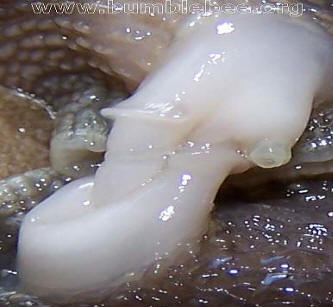
Reproduction
Most terrestrial snails are hermaphrodites, meaning that they act as male and female. This allows the snails to mate with any individual within their species (Biology Online 2011).
To mate each snail gives a spermatophore to the other, this is done through the genital pores of each snail. The snails transfer the spermatophore to the other snail's genital pore by their penis which comes from their own genital pore. The genital pore of the snail is located behind the head and the side to which it is located depends on which way the shell coils. The mating process can take up to several hours, meaning the snails can be attached for quite a while (Biology Online 2011).
The eggs are then secreted in a gelatinous mass from the genital pore once they are ready to be deposited. Terrestrial gastropods have direct development, meaning they have no larval stage, they hatch into a juvenile adult (Land Snails of Wisconsin 2011).
